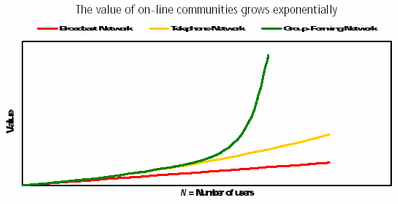| Group Forming Networks | 2002-11-10 19:09 4 comments |
 by Flemming Funch by Flemming FunchDavid Reed talks about Group Forming. David Reed is an Internet veteran credited with what is sometimes called Reed's Law, which says, essentially, that networks that facilitate easy group forming are subject to potentially exponential growth. So, here's a little bit of math: Broadcast media or traditional industrial age businesses grow roughly in ratio to how many listeners or customers they have. Twice as many listeners/viewers means twice as good. Twice as many people who see your ad means twice as many customers which means twice as good. We can use the symbol N for the value. N number of people gives a value of N. That is called proportional growth. But if we're talking about a network, where the participants can communicate with each other, the rules change. Bob Metcalfe, the inventor of Ethernet, noticed that, and it is known as Metcalfe's Law that the value of a network increases with the square of the number of members. Think about the phone system. If you can only talk with a few people it isn't worth much. The more people you can call, the more valuable it is. Twice as many people make it not just twice as good, but four times (the square) as good. Roughly. So, the value is N2. And now David Reed says that if we're talking about not just a network, but a community, the rules change again. The number of different interactions that might happen within a group of N people would be 2N. That is what is called exponential growth. So, if the members of the network can't just communicate one-to-one, but they can get together in groups of all kinds of sizes, the potential value is huge. That's maybe a bit tenuous, as there's nothing at all automatic about it. It is what potentially can happen. But useful groups don't necessarily form just because it is possible for them to do so. I am, however, extremely interested in discovering factors that help groups to form and to self-organize. So, what it is that actually creates a Group Forming Network (GFN)? I'm not sure if Reed has an answer, but I'll keep looking. One third of a century ago in an article entitled "The Computer as a Communication Medium," J.C.R. Licklider and Bob Taylor wrote the following, which was part of what inspired David Reed and others to build the first Internet: What will on-line interactive communities be like? Â… they will consist of geographically separated members Â… communities not of common location, but of common interest. Â… The whole will constitute a labile network of networks-ever changing in both content and configuration. Â… the impact Â… will be very great-both on the individual and on society. Â… First, Â… because the people with whom one interacts will be selected more by commonality Â… than by accidents of proximity. |